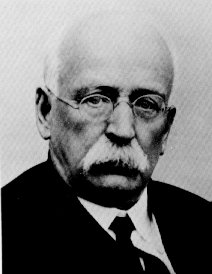Ebenezer Howard
Ebenezer Howard (29 January 1850 – 1 May 1928) was an English urban planner and founder of the garden city movement, which aimed to create self-contained communities surrounded by "greenbelts", containing proportionate areas of residences, industry, and agriculture. His ideas were influential in the development of modern urban planning and have had a lasting impact on the design of cities around the world.
Early Life[edit | edit source]
Ebenezer Howard was born in the city of London, England. He was educated at several schools in London and later worked as a stenographer. In 1871, he emigrated to the United States, where he worked on a farm in Nebraska and later in Chicago as a reporter for the courts and newspapers.
Garden City Movement[edit | edit source]
Howard's most significant contribution to urban planning was the development of the garden city concept, which he detailed in his book Garden Cities of To-morrow (1898). The garden city was intended to combine the benefits of the urban and rural environments while avoiding the disadvantages of both. Howard envisioned a series of small, self-sufficient cities surrounded by greenbelts, with a balanced mix of housing, industry, and agriculture.
Principles of Garden Cities[edit | edit source]
The key principles of Howard's garden city concept included:
- Self-contained communities with a population limit of around 32,000 people.
- A concentric pattern with open spaces, public parks, and boulevards.
- A mix of residential, industrial, and agricultural areas.
- Community ownership of land to prevent speculation and ensure long-term planning.
Implementation[edit | edit source]
The first garden city, Letchworth Garden City, was founded in 1903 in Hertfordshire, England. It was followed by Welwyn Garden City in 1920. These cities were designed according to Howard's principles and served as models for future developments.
Legacy[edit | edit source]
Howard's ideas have had a profound influence on urban planning and the development of new towns. The garden city movement inspired the creation of numerous planned communities around the world, including Greenbelt, Maryland, and Reston, Virginia in the United States, and Harlow and Milton Keynes in the United Kingdom.
Related Pages[edit | edit source]
- Garden city movement
- Letchworth Garden City
- Welwyn Garden City
- Urban planning
- Greenbelt, Maryland
- Reston, Virginia
- Harlow
- Milton Keynes
See Also[edit | edit source]
References[edit | edit source]
External Links[edit | edit source]
Search WikiMD
Ad.Tired of being Overweight? Try W8MD's physician weight loss program.
Semaglutide (Ozempic / Wegovy and Tirzepatide (Mounjaro / Zepbound) available.
Advertise on WikiMD
|
WikiMD's Wellness Encyclopedia |
| Let Food Be Thy Medicine Medicine Thy Food - Hippocrates |
Translate this page: - East Asian
中文,
日本,
한국어,
South Asian
हिन्दी,
தமிழ்,
తెలుగు,
Urdu,
ಕನ್ನಡ,
Southeast Asian
Indonesian,
Vietnamese,
Thai,
မြန်မာဘာသာ,
বাংলা
European
español,
Deutsch,
français,
Greek,
português do Brasil,
polski,
română,
русский,
Nederlands,
norsk,
svenska,
suomi,
Italian
Middle Eastern & African
عربى,
Turkish,
Persian,
Hebrew,
Afrikaans,
isiZulu,
Kiswahili,
Other
Bulgarian,
Hungarian,
Czech,
Swedish,
മലയാളം,
मराठी,
ਪੰਜਾਬੀ,
ગુજરાતી,
Portuguese,
Ukrainian
Medical Disclaimer: WikiMD is not a substitute for professional medical advice. The information on WikiMD is provided as an information resource only, may be incorrect, outdated or misleading, and is not to be used or relied on for any diagnostic or treatment purposes. Please consult your health care provider before making any healthcare decisions or for guidance about a specific medical condition. WikiMD expressly disclaims responsibility, and shall have no liability, for any damages, loss, injury, or liability whatsoever suffered as a result of your reliance on the information contained in this site. By visiting this site you agree to the foregoing terms and conditions, which may from time to time be changed or supplemented by WikiMD. If you do not agree to the foregoing terms and conditions, you should not enter or use this site. See full disclaimer.
Credits:Most images are courtesy of Wikimedia commons, and templates, categories Wikipedia, licensed under CC BY SA or similar.
Contributors: Prab R. Tumpati, MD




